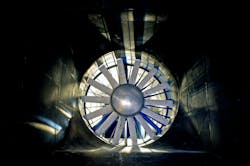NASA seeks turbine air motors for wind tunnel propulsion testing
Questions and answers:
What is NASA requesting in this solicitation? NASA is seeking four turbine air motors to support propulsion-airframe integration testing in the Ames 11-by-11-foot Unitary Plan Wind Tunnel.
What will the turbine air motors be used for? They will be integrated into a wing-body model to simulate propfan propulsion and measure aerodynamic performance at high-speed cruise conditions.
What are the key technical requirements? The motors must be compact, reversible, support both single and contra-rotating fans, operate in upright or inverted orientations, and run up to 20,000 RPM with as much as 170 horsepower.
CLEVELAND - The National Aeronautics and Space Administration's (NASA) Glenn Research Center is requesting industry quotes for four turbine air motors (TAMs) to support propulsion-airframe integration testing at the Ames Research Center 11-by-11-foot Unitary Plan Wind Tunnel in California. The acquisition is being conducted under solicitation number 80GRC025Q0001, with proposals due by 5 Sept. 2025.
The procurement will provide two primary turbine motors and two backup units that will be mounted on an airframe body-and-wing model for aerodynamic performance studies at high-speed cruise conditions. According to NASA, the specifications are designed to ensure that the motors are compact, adaptable, and capable of supporting a wide range of propulsor configurations.
NASA’s requirements emphasize flexibility and reliability to avoid the time and cost of designing new powered propulsion hardware. The turbine air motors must be able to operate in isolated and installed testing, as well as in upright or inverted orientations, to accommodate different mounting systems. They also must be capable of running in multiple wind tunnel facilities, provided a suitable power source is available, whether electric, pneumatic, or hydraulic.
Related: NASA, ANU team up for Artemis II lunar laser communications test
SWaP a prioritiy
To support realistic propulsion simulations, the motors are required to be as compact as possible, with a target outer diameter of less than four inches. State-of-the-art power density is a priority, and the units must fit within nacelle lines appropriate for scaled transonic wind tunnel models. NASA also specifies that the motors must be reversible to simulate both tractor and pusher engine arrangements, and they must support either single or contra-rotating fan designs to cover different propfan engine concepts.
The solicitation also requires that the TAMs be capable of locked operation to represent feathered blades in the event of an in-flight shutdown or blade-out scenario. Reliability is a major concern, since aerodynamic test campaigns can run for several months with powered operation occurring at least half of the time. To maintain uninterrupted testing, the agency will acquire multiple handed configurations - clockwise and counterclockwise - so that propulsors on opposite wings can be simulated realistically. At least four copies of the motors, two for each handed orientation, will be available as spares.
Additional specifications include the ability to accept rotating shaft balances for thrust measurement and compatibility with both open- and closed-circuit nacelle hardware. Closed-circuit designs are important for noise testing, as they prevent propulsion airflow from being discharged directly into the wind tunnel.
In terms of performance, NASA’s requirements list a nominal power capability of 100 horsepower with a maximum of 170 horsepower, a maximum rotational speed of 17,000 RPM with a desired capability up to 20,000 RPM, and a size envelope less than four inches in diameter with a goal of under three inches. The motors must also accommodate rotating force balances, an important element for thrust and drag bookkeeping, as well as computational fluid dynamics validation.
Offers are due to Kevin Carroll at NASA Glenn Research Center, who can be reached at [email protected]. More information is available at https://sam.gov/workspace/contract/opp/71ca2e6240d94d77a0fa9cfe67f7bc2f/view.
About the Author
Jamie Whitney
Senior Editor
Jamie Whitney joined the staff of Military & Aerospace Electronics in 2018 and oversees editorial content and produces news and features for Military & Aerospace Electronics, attends industry events, produces Webcasts, and oversees print production of Military & Aerospace Electronics.
